Virtual Reality and Interactive 360º storytelling have many great applications. However, its most powerful application is when it is used to immerse viewers into the world of others – transporting them to foreign places to walk in other people’s shoes, to experience their lives and hopefully to discover a different perspective. A tool that can create curriculum-aligned VR projects for all ages.
The Water in the World – Water Cycle VR project for Stage 4 Geography class (Year 10) was created by one of our schools, Erina High School from the Central Coast, NSW, Australia using the VRTY platform.
Creator: Grant Ward (Head Teacher Administration)
Footage: Captured by Grant in the Yosemite Valley (Swinging Bridge trail) using the Insta360 OneX camera.
Experience Water in the World – Water Cycle in VR/360º
We recommend you read through the viewing guide to set up for each device to have the best VR/360º experience.
Recommended browser is Google Chrome.
Download Water Cycle Lesson Plan
Get your free Water Cycle in VR/360º Lesson Plan for your next classroom activity. All you have to do is to put your details in and the full Water Cycle lesson plan will be in your inbox within minutes.
Free Water Cycle lesson plan includes:
- Teacher Guide
- Student Worksheet
- Water Cycle VR/360º

